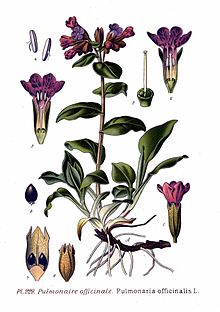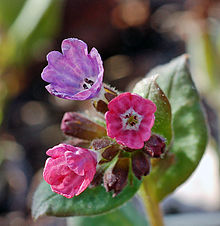Spotted lungwort
| Spotted lungwort | ||||||||||||
|---|---|---|---|---|---|---|---|---|---|---|---|---|

Spotted lungwort ( Pulmonaria officinalis ) |
||||||||||||
| Systematics | ||||||||||||
|
||||||||||||
| Scientific name | ||||||||||||
| Pulmonaria officinalis | ||||||||||||
| L. |
The spotted lungwort ( Pulmonaria officinalis ), also known as real lungwort , is a plant species within the family of the predatory leaf family (Boraginaceae). It is common in Europe .
Common names
Other common names are: Hansel and Gretel, little brother and sister (because of the different flower colors), brook herb, blue cowslip, fenugreek, spotted herb, heaven key , deer cabbage, deer changold, trousers, lungwort, Schlotterhose, sister herb, unequal sisters, our dear women milk herb.
description
Vegetative characteristics
The spotted lungwort is a perennial herbaceous plant . The heart-egg-shaped basal leaves are mostly coarse, fully developed and undivided. They are yellow-green and always have round, often sharply defined, white spots. The top of the leaves is provided with tiny spiked bumps and only a few bristle hairs. The non-flowering shoots have an egg-shaped blade that is longer than its 15 centimeter long petiole and can suddenly merge into the stem.
Generative characteristics
The hermaphroditic flowers are radial symmetry and five-fold with a double flower envelope . The five sepals are fused to at least half of their length. When the flower is freshly opened, the calyx is V-shaped and about twice as long as it is wide. The corolla is initially red, later changing color to blue during anthesis due to a change in the pH value within the petals. Two carpels are a top permanent ovary deformed, by a false partition into four compartments ( Klausen is divided).
When ripe, the Klaus fruit breaks down into four partial fruits.
The spotted lungwort is diploid and has chromosome number 2n = 14 or 16.
ecology
The spotted lungwort is an evergreen hemicryptophyte , a semi-rosette plant with a rather thin rhizome . It is a clay pointer and gauze soil rooter. It likes to grow in partial shade. The spotted lungwort is a light germ .
From an ecological point of view, these are mostly homogamous "plate flowers with enclosed anthers and stigmas". They are initially red-purple and later purple-blue. They have a high level of UV reflection . The crown remains in place for about six to eight days, and the color changes after 3 to 4 days. The pollinators - first of all the long-nosed wild bee species Anthophora plumipes , later another species from the same genus - prefer the young red flowers, which contain more nectar than the blue ones . The nectar is protected by a hairline on the relatively small gullet scales at the entrance to the corolla tube and, because of the approximately 1 centimeter long corolla tube, only accessible to long- nosed bees and butterflies . Hover flies eat the pollen . The flowers are different to the touch and are self-sterile. The flowering period is between March and May.
The Klausen are provided with an oil body called elaiosome . They are spread by ants . When ripe, the fruit stem bends towards the ground and the fruit becomes a self-sower . Fruit ripening takes place between May and June.
Occurrence

Pulmonaria officinalis is widespread in large parts of Europe: west to the Ardennes , north to the Netherlands , Denmark and central Sweden . It is absent in Norway, but is only naturalized in the British Isles. The spotted lungwort is found to the east as far as central Russia and the Caucasus , to the south it occurs in the northern Balkans and as far as central Italy .
The spotted lungwort grows in herbaceous deciduous and mixed beech forests and their edges from the plains to the mountains up to altitudes of around 1300 meters. It is more common in the south than in the north. It thrives best on fresh, nutrient-rich and base-rich, mostly calcareous, stony or pure clay and loam soils . It is a character species of the order Fagetalia and occurs particularly in societies of the associations Fagion and Alno-Ulmion.
Taxonomy and naming
The name Pulmonaria comes from the Latin pulmo = lung. The spotted lungwort has been used against lung diseases since the Middle Ages. Hildegard von Bingen calls it lungwort.
The first publication of Pulmonaria officinalis was done by Carl von Linné . Synonyms of Pulmonaria officinalis L. are: Pulmonaria konradii Opiz , Pulmonaria maculosa Liebl. , Pulmonaria tridentina Evers , Pulmonaria officinalis subsp. maculosa (Hayne) chamois .
ingredients
The spotted lungwort contains, among other things, silicic acid , mucus , saponins , tannins and large amounts of minerals and thus has an anti-cough and anti-inflammatory effect. The flowers contain a dye that belongs to the anthocyanins - it changes color from red (acidic) to blue (basic) when the acidity changes.
literature
- Henning Haeupler, Thomas Muer: picture atlas of the fern and flowering plants of Germany . Ed .: Federal Agency for Nature Conservation (= The fern and flowering plants of Germany . Volume 2 ). Eugen Ulmer, Stuttgart (Hohenheim) 2000, ISBN 3-8001-3364-4 .
- Gustav Hegi: Illustrated flora of Central Europe. Pteridophyta, Spermatophyta . 2nd Edition. Volume V. Part 3: Angiospermae: Dicotyledones 3 (3) (Pirolaceae - Verbenaceae) . Carl Hanser and Paul Parey, Munich and Berlin / Hamburg 1966, ISBN 3-489-76020-4 , pp. 2213–2216 (unchanged reprint of the 1st edition from 1927 with addendum).
- Erich Oberdorfer : Plant-sociological excursion flora . With the collaboration of Theo Müller. 7th, revised and expanded edition. Eugen Ulmer, Stuttgart (Hohenheim) 1994, ISBN 3-8252-1828-7 .
- Ruprecht Düll , Herfried Kutzelnigg : Pocket dictionary of plants in Germany and neighboring countries. The most common Central European species in portrait . 7th, corrected and enlarged edition. Quelle & Meyer, Wiebelsheim 2011, ISBN 978-3-494-01424-1 .
Individual evidence
- ↑ Pulmonaria officinalis subsp. maculosa at Tropicos.org. In: IPCN Chromosome Reports . Missouri Botanical Garden, St. Louis
- ^ Erich Oberdorfer : Plant-sociological excursion flora for Germany and neighboring areas . With the collaboration of Angelika Schwabe and Theo Müller. 8th, heavily revised and expanded edition. Eugen Ulmer, Stuttgart (Hohenheim) 2001, ISBN 3-8001-3131-5 , pp. 786-787 .
Web links
- Pulmonaria officinalis agg., Spotted lungwort (species group). In: FloraWeb.de.
- Pulmonaria officinalis L., spotted lungwort. In: FloraWeb.de.
- Profile and distribution map for Bavaria . In: Botanical Information Hub of Bavaria .
- Spotted lungwort . In: BiolFlor, the database of biological-ecological characteristics of the flora of Germany.
- Pulmonaria officinalis L. In: Info Flora , the national data and information center for Swiss flora . Retrieved February 10, 2016.
- Distribution in the northern hemisphere according to Eric Hultén
- Thomas Meyer: Lung herb data sheet with identification key and photos at Flora-de: Flora von Deutschland (old name of the website: Flowers in Swabia ).



